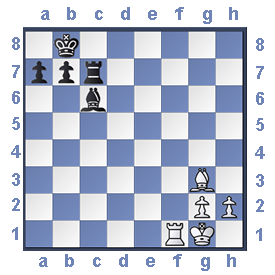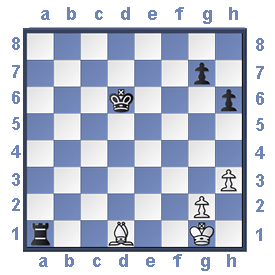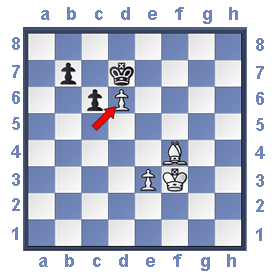When two enemy pieces are in a straight line, either on a rank, file or diagonal they can be attacked by pieces that move in that way (Queen, Bishop or Rook).
|
The Rook cannot move because the King would be in check from the White Bishop.
The Rook is said to be PINNED by the Bishop. |
 |
| He cannot move the Bishop because the King would be in check from the Black Rook. The white Bishop is PINNED. In this case The Bishop is lost because next move the Black Rook will take it. |
 |
| . If the White Knight was to move then the Black Queen would capture the White Rook next move. So the Knight is said to be PINNED. |
 |
T his pinning move can be made extreme;y effective by attacking it a second time, with another piece. Here is a position where a Rook is pinned against the king by a Bishop but there is a nearby pawn! his pinning move can be made extreme;y effective by attacking it a second time, with another piece. Here is a position where a Rook is pinned against the king by a Bishop but there is a nearby pawn!
White could play BxR+ and Black would reply ...KxB. White gains a piece worth 5 Pawns and loses one worth 3 Pawns. This is called 'winning the exchange'. There is a better move for White by attacking the pinned Rook twice he can win this Rook without losing the Bishop at all. |
| c5! The pinned and helpless Rook is now attacked again by the Pawn. |
 |
Black has to move - he moves his King (K-d7 ).
The Rook is no longer pinned but it is White's move. |
 |
| White moves and takes the Rook with his Pawn (c5xd6). White has won the Rook for nothing as theKing cannot recapture the Pawn. |
 |
| |
|









 his pinning move can be made extreme;y effective by attacking it a second time, with another piece. Here is a position where a Rook is pinned against the king by a Bishop but there is a nearby pawn!
his pinning move can be made extreme;y effective by attacking it a second time, with another piece. Here is a position where a Rook is pinned against the king by a Bishop but there is a nearby pawn!


 DISCLAIMER: The information given in this site is presented in good faith, but the site-author is human and does make mistakes! Should you find anything that you believe is in error please notify the Webmaster of your finding.
DISCLAIMER: The information given in this site is presented in good faith, but the site-author is human and does make mistakes! Should you find anything that you believe is in error please notify the Webmaster of your finding.